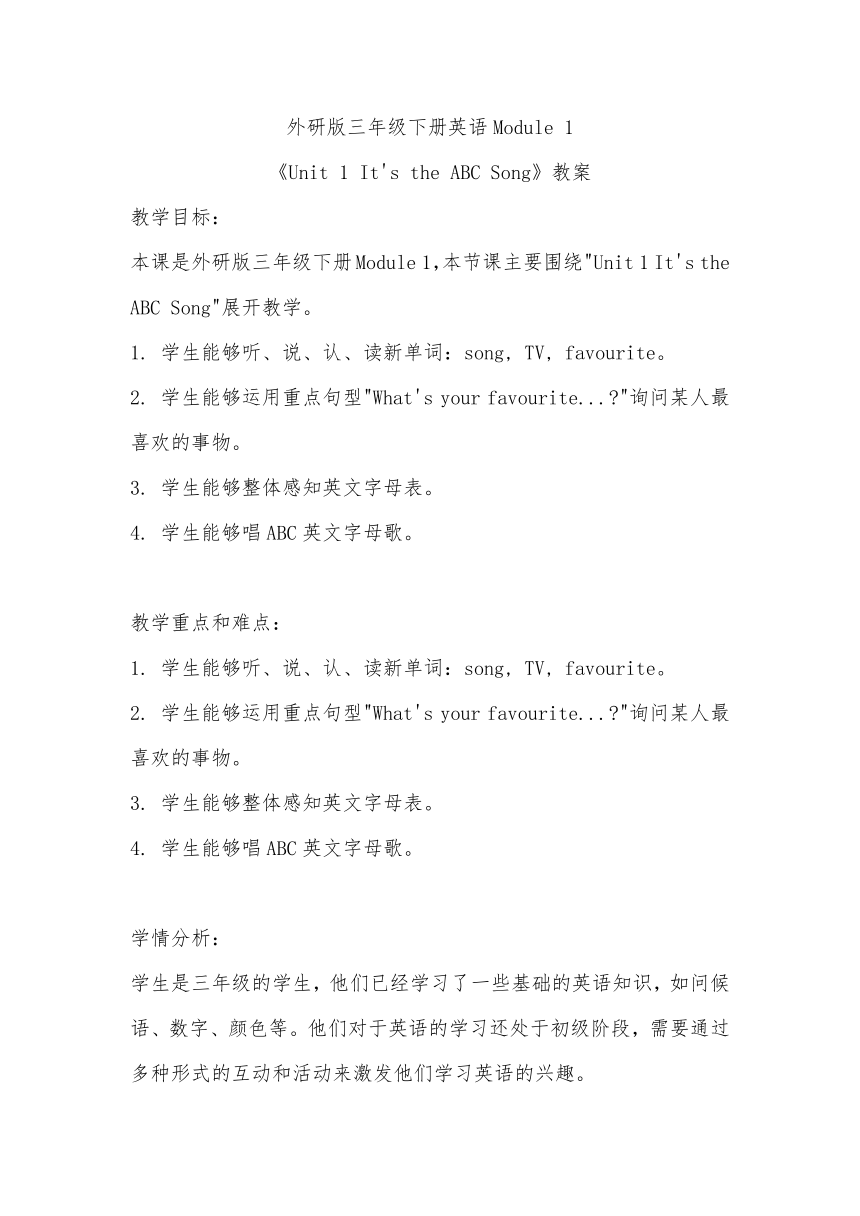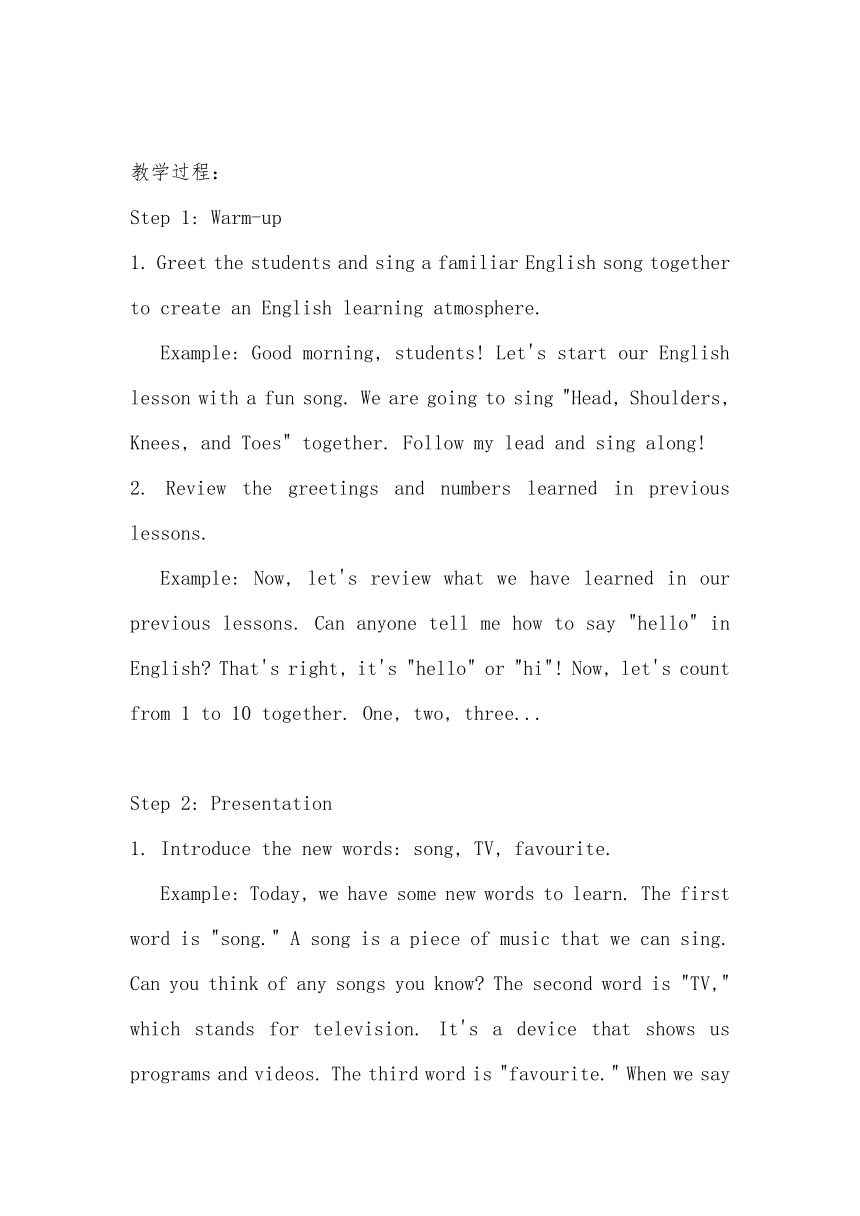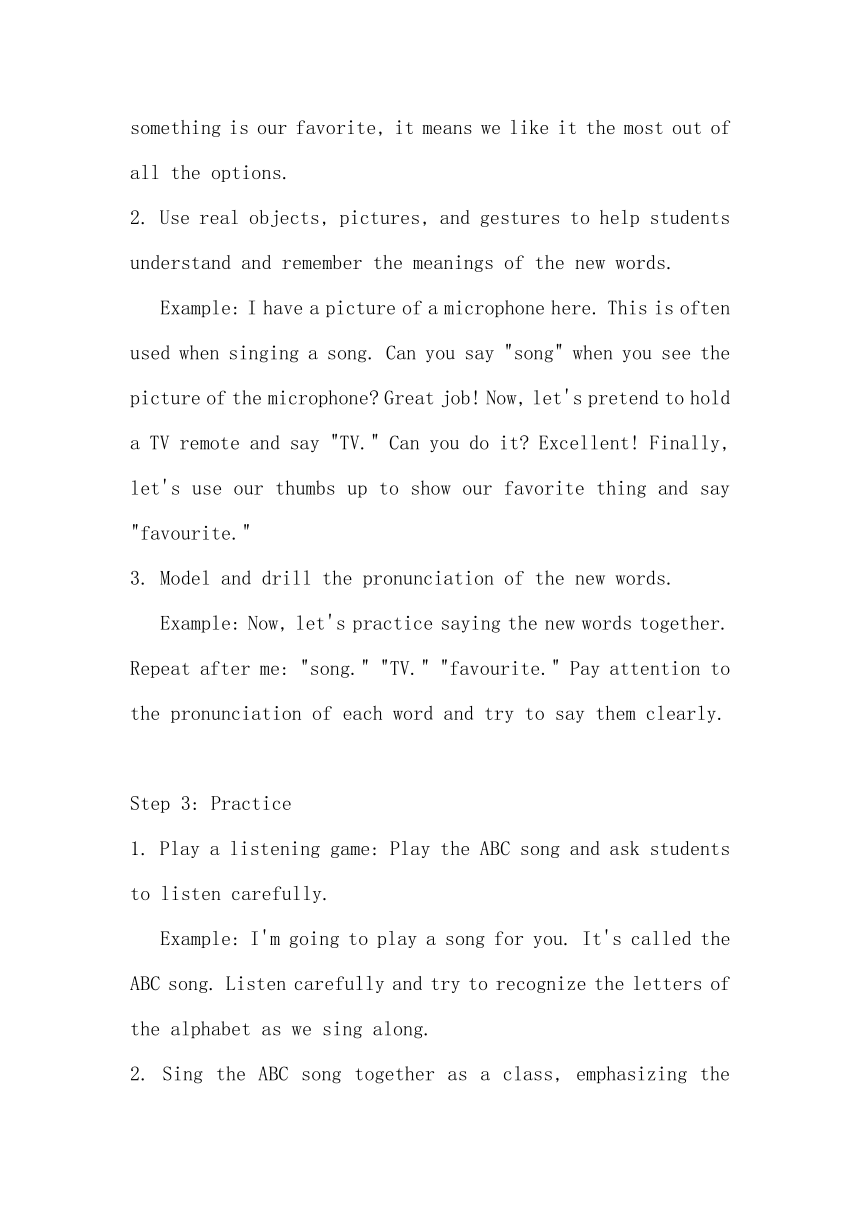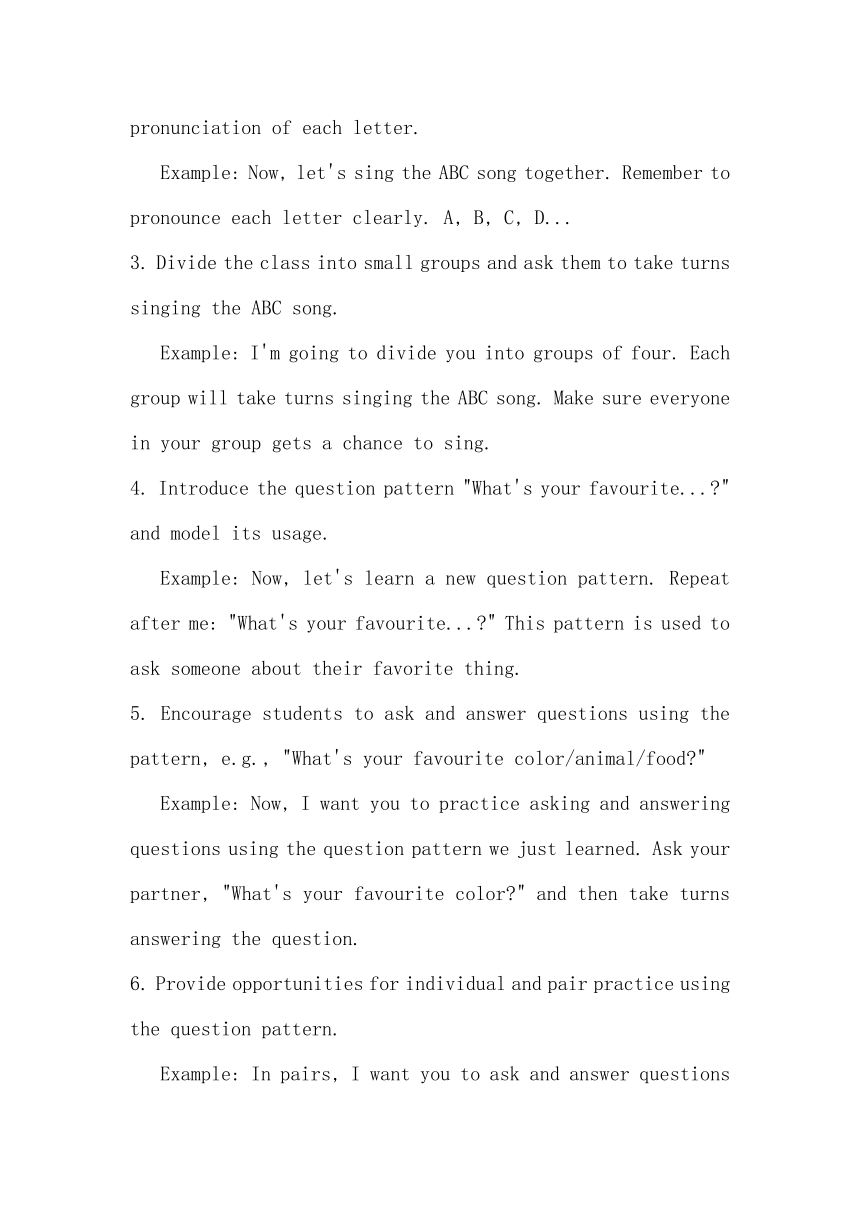Module 1 Unit 1 It's the ABC Song 教案
文档属性
| 名称 | Module 1 Unit 1 It's the ABC Song 教案 |  | |
| 格式 | docx | ||
| 文件大小 | 14.1KB | ||
| 资源类型 | 教案 | ||
| 版本资源 | 外研版(三年级起点) | ||
| 科目 | 英语 | ||
| 更新时间 | 2024-01-25 07:50:54 | ||
图片预览




文档简介
外研版三年级下册英语Module 1
《Unit 1 It's the ABC Song》教案
教学目标:
本课是外研版三年级下册Module 1,本节课主要围绕"Unit 1 It's the ABC Song"展开教学。
1. 学生能够听、说、认、读新单词:song, TV, favourite。
2. 学生能够运用重点句型"What's your favourite... "询问某人最喜欢的事物。
3. 学生能够整体感知英文字母表。
4. 学生能够唱ABC英文字母歌。
教学重点和难点:
1. 学生能够听、说、认、读新单词:song, TV, favourite。
2. 学生能够运用重点句型"What's your favourite... "询问某人最喜欢的事物。
3. 学生能够整体感知英文字母表。
4. 学生能够唱ABC英文字母歌。
学情分析:
学生是三年级的学生,他们已经学习了一些基础的英语知识,如问候语、数字、颜色等。他们对于英语的学习还处于初级阶段,需要通过多种形式的互动和活动来激发他们学习英语的兴趣。
教学过程:
Step 1: Warm-up
1. Greet the students and sing a familiar English song together to create an English learning atmosphere.
Example: Good morning, students! Let's start our English lesson with a fun song. We are going to sing "Head, Shoulders, Knees, and Toes" together. Follow my lead and sing along!
2. Review the greetings and numbers learned in previous lessons.
Example: Now, let's review what we have learned in our previous lessons. Can anyone tell me how to say "hello" in English That's right, it's "hello" or "hi"! Now, let's count from 1 to 10 together. One, two, three...
Step 2: Presentation
1. Introduce the new words: song, TV, favourite.
Example: Today, we have some new words to learn. The first word is "song." A song is a piece of music that we can sing. Can you think of any songs you know The second word is "TV," which stands for television. It's a device that shows us programs and videos. The third word is "favourite." When we say something is our favorite, it means we like it the most out of all the options.
2. Use real objects, pictures, and gestures to help students understand and remember the meanings of the new words.
Example: I have a picture of a microphone here. This is often used when singing a song. Can you say "song" when you see the picture of the microphone Great job! Now, let's pretend to hold a TV remote and say "TV." Can you do it Excellent! Finally, let's use our thumbs up to show our favorite thing and say "favourite."
3. Model and drill the pronunciation of the new words.
Example: Now, let's practice saying the new words together. Repeat after me: "song." "TV." "favourite." Pay attention to the pronunciation of each word and try to say them clearly.
Step 3: Practice
1. Play a listening game: Play the ABC song and ask students to listen carefully.
Example: I'm going to play a song for you. It's called the ABC song. Listen carefully and try to recognize the letters of the alphabet as we sing along.
2. Sing the ABC song together as a class, emphasizing the pronunciation of each letter.
Example: Now, let's sing the ABC song together. Remember to pronounce each letter clearly. A, B, C, D...
3. Divide the class into small groups and ask them to take turns singing the ABC song.
Example: I'm going to divide you into groups of four. Each group will take turns singing the ABC song. Make sure everyone in your group gets a chance to sing.
4. Introduce the question pattern "What's your favourite... " and model its usage.
Example: Now, let's learn a new question pattern. Repeat after me: "What's your favourite... " This pattern is used to ask someone about their favorite thing.
5. Encourage students to ask and answer questions using the pattern, e.g., "What's your favourite color/animal/food "
Example: Now, I want you to practice asking and answering questions using the question pattern we just learned. Ask your partner, "What's your favourite color " and then take turns answering the question.
6. Provide opportunities for individual and pair practice using the question pattern.
Example: In pairs, I want you to ask and answer questions about your favorite things. Use the question pattern "What's your favourite... " and talk about your favorite color, animal, and food. Take turns asking and answering.
Step 4: Consolidation
1. Use flashcards or a PowerPoint presentation to show the letters of the alphabet.
Example: Now, let's review the letters of the alphabet. I have flashcards with each letter. I will show you a flashcard, and I want you to tell me the name of the letter.
2. Practice letter recognition by asking students to point to the letters as you call them out.
Example: Point to the letter "A." Excellent! Now, find the letter "B." Well done! Let's continue with the other letters.
3. Ask individual students to come to the board and write a letter they recognize.
Example: Sarah, please come to the board and write the letter "C." Great job, Sarah! Who can come and write the letter "D"
4. Sing the ABC song again, encouraging students to sing along and point to the corresponding letters.
Example: Let's sing the ABC song one more time. As we sing, point to the corresponding letters on the flashcards or PowerPoint slides. This will help reinforce your letter recognition skills.
Step 5: Extension
1. Show a video or use visual aids to introduce different songs and TV shows in English.
Example: Now, I have avideo to show you some popular songs and TV shows in English. Watch carefully and pay attention to the words and expressions used in the songs and shows.
2. Ask students to share their favorite songs or TV shows in English, using the question pattern "What's your favourite song/TV show "
Example: Now, I want each of you to think about your favorite song or TV show in English. When I call your name, please share with the class your favorite song or TV show and why you like it. Remember to use the question pattern "What's your favourite song/TV show "
Step 6: Wrap-up
1. Review the new words, the question pattern, and the letters of the alphabet.
Example: Let's review what we have learned today. Can anyone tell me the new words we learned That's right, they are "song," "TV," and "favourite." Now, who remembers the question pattern we practiced Excellent! It's "What's your favourite... " Finally, let's go through the letters of the alphabet one more time. I'll say a letter, and you show me its flashcard or point to it on the PowerPoint.
2. Summarize what the students have learned in this lesson.
Example: Today, we learned new words related to music and television, practiced the question pattern "What's your favourite... ", reviewed the letters of the alphabet, and even shared our favorite songs and TV shows. You all did a fantastic job participating and practicing your English skills. Well done!
板书设计:
Unit 1 It's the ABC Song
New Words: song, TV, favourite
Question Pattern: What's your favourite...
教学反思:
本节课通过多种形式的互动和活动,使学生在轻松愉快的氛围中学习了新单词、重点句型和英文字母表。通过听歌、唱歌、问答等活动,培养了学生的听说能力,同时激发了他们对英语学习的兴趣。在教学过程中,教师要注重激发学生的参与和积极性,及时给予肯定和鼓励,帮助学生克服困难,提高学习效果。同时,教师也要根据学生的实际情况进行适当的调整和个别辅导,确保每个学生都能够参与到课堂活动中来。在评估学生的学习效果时,可以通过观察他们的表现、问答、个别检查等方式进行。总体而言,本节课的教学目标能够有效地达到,并且通过丰富多样的活动设计,使学生在积极参与中提高了英语的听说能力,同时也培养了他们的学习兴趣和自信心。
《Unit 1 It's the ABC Song》教案
教学目标:
本课是外研版三年级下册Module 1,本节课主要围绕"Unit 1 It's the ABC Song"展开教学。
1. 学生能够听、说、认、读新单词:song, TV, favourite。
2. 学生能够运用重点句型"What's your favourite... "询问某人最喜欢的事物。
3. 学生能够整体感知英文字母表。
4. 学生能够唱ABC英文字母歌。
教学重点和难点:
1. 学生能够听、说、认、读新单词:song, TV, favourite。
2. 学生能够运用重点句型"What's your favourite... "询问某人最喜欢的事物。
3. 学生能够整体感知英文字母表。
4. 学生能够唱ABC英文字母歌。
学情分析:
学生是三年级的学生,他们已经学习了一些基础的英语知识,如问候语、数字、颜色等。他们对于英语的学习还处于初级阶段,需要通过多种形式的互动和活动来激发他们学习英语的兴趣。
教学过程:
Step 1: Warm-up
1. Greet the students and sing a familiar English song together to create an English learning atmosphere.
Example: Good morning, students! Let's start our English lesson with a fun song. We are going to sing "Head, Shoulders, Knees, and Toes" together. Follow my lead and sing along!
2. Review the greetings and numbers learned in previous lessons.
Example: Now, let's review what we have learned in our previous lessons. Can anyone tell me how to say "hello" in English That's right, it's "hello" or "hi"! Now, let's count from 1 to 10 together. One, two, three...
Step 2: Presentation
1. Introduce the new words: song, TV, favourite.
Example: Today, we have some new words to learn. The first word is "song." A song is a piece of music that we can sing. Can you think of any songs you know The second word is "TV," which stands for television. It's a device that shows us programs and videos. The third word is "favourite." When we say something is our favorite, it means we like it the most out of all the options.
2. Use real objects, pictures, and gestures to help students understand and remember the meanings of the new words.
Example: I have a picture of a microphone here. This is often used when singing a song. Can you say "song" when you see the picture of the microphone Great job! Now, let's pretend to hold a TV remote and say "TV." Can you do it Excellent! Finally, let's use our thumbs up to show our favorite thing and say "favourite."
3. Model and drill the pronunciation of the new words.
Example: Now, let's practice saying the new words together. Repeat after me: "song." "TV." "favourite." Pay attention to the pronunciation of each word and try to say them clearly.
Step 3: Practice
1. Play a listening game: Play the ABC song and ask students to listen carefully.
Example: I'm going to play a song for you. It's called the ABC song. Listen carefully and try to recognize the letters of the alphabet as we sing along.
2. Sing the ABC song together as a class, emphasizing the pronunciation of each letter.
Example: Now, let's sing the ABC song together. Remember to pronounce each letter clearly. A, B, C, D...
3. Divide the class into small groups and ask them to take turns singing the ABC song.
Example: I'm going to divide you into groups of four. Each group will take turns singing the ABC song. Make sure everyone in your group gets a chance to sing.
4. Introduce the question pattern "What's your favourite... " and model its usage.
Example: Now, let's learn a new question pattern. Repeat after me: "What's your favourite... " This pattern is used to ask someone about their favorite thing.
5. Encourage students to ask and answer questions using the pattern, e.g., "What's your favourite color/animal/food "
Example: Now, I want you to practice asking and answering questions using the question pattern we just learned. Ask your partner, "What's your favourite color " and then take turns answering the question.
6. Provide opportunities for individual and pair practice using the question pattern.
Example: In pairs, I want you to ask and answer questions about your favorite things. Use the question pattern "What's your favourite... " and talk about your favorite color, animal, and food. Take turns asking and answering.
Step 4: Consolidation
1. Use flashcards or a PowerPoint presentation to show the letters of the alphabet.
Example: Now, let's review the letters of the alphabet. I have flashcards with each letter. I will show you a flashcard, and I want you to tell me the name of the letter.
2. Practice letter recognition by asking students to point to the letters as you call them out.
Example: Point to the letter "A." Excellent! Now, find the letter "B." Well done! Let's continue with the other letters.
3. Ask individual students to come to the board and write a letter they recognize.
Example: Sarah, please come to the board and write the letter "C." Great job, Sarah! Who can come and write the letter "D"
4. Sing the ABC song again, encouraging students to sing along and point to the corresponding letters.
Example: Let's sing the ABC song one more time. As we sing, point to the corresponding letters on the flashcards or PowerPoint slides. This will help reinforce your letter recognition skills.
Step 5: Extension
1. Show a video or use visual aids to introduce different songs and TV shows in English.
Example: Now, I have avideo to show you some popular songs and TV shows in English. Watch carefully and pay attention to the words and expressions used in the songs and shows.
2. Ask students to share their favorite songs or TV shows in English, using the question pattern "What's your favourite song/TV show "
Example: Now, I want each of you to think about your favorite song or TV show in English. When I call your name, please share with the class your favorite song or TV show and why you like it. Remember to use the question pattern "What's your favourite song/TV show "
Step 6: Wrap-up
1. Review the new words, the question pattern, and the letters of the alphabet.
Example: Let's review what we have learned today. Can anyone tell me the new words we learned That's right, they are "song," "TV," and "favourite." Now, who remembers the question pattern we practiced Excellent! It's "What's your favourite... " Finally, let's go through the letters of the alphabet one more time. I'll say a letter, and you show me its flashcard or point to it on the PowerPoint.
2. Summarize what the students have learned in this lesson.
Example: Today, we learned new words related to music and television, practiced the question pattern "What's your favourite... ", reviewed the letters of the alphabet, and even shared our favorite songs and TV shows. You all did a fantastic job participating and practicing your English skills. Well done!
板书设计:
Unit 1 It's the ABC Song
New Words: song, TV, favourite
Question Pattern: What's your favourite...
教学反思:
本节课通过多种形式的互动和活动,使学生在轻松愉快的氛围中学习了新单词、重点句型和英文字母表。通过听歌、唱歌、问答等活动,培养了学生的听说能力,同时激发了他们对英语学习的兴趣。在教学过程中,教师要注重激发学生的参与和积极性,及时给予肯定和鼓励,帮助学生克服困难,提高学习效果。同时,教师也要根据学生的实际情况进行适当的调整和个别辅导,确保每个学生都能够参与到课堂活动中来。在评估学生的学习效果时,可以通过观察他们的表现、问答、个别检查等方式进行。总体而言,本节课的教学目标能够有效地达到,并且通过丰富多样的活动设计,使学生在积极参与中提高了英语的听说能力,同时也培养了他们的学习兴趣和自信心。
同课章节目录
- Module 1
- Unit 1 It's the ABC song.
- Unit 2 My favourite colour is yellow.
- Module 2
- Unit 1 They are monkeys.
- Unit 2 The man is short.
- Module 3
- Unit 1 I like football.
- Unit 2 I don't like riding my bike.
- Module 4
- Unit 1 Do you like meat?
- Unit 2 Does Lingling like oranges?
- Module 5
- Unit 1 She goes to school on Mondays.
- Unit 2 Does your mum go to work on Saturdays?
- Module 6
- Unit 1 What do you do on Sundays?
- Unit 2 What does Lingling have at school?
- Module 7
- Unit 1 We fly kites in spring.
- Unit 2 It's warm today.
- Module 8
- Unit 1 It's on your desk.
- Unit 2 Daming flies a kite in the park.
- Module 9
- Unit 1 I've got a new book.
- Unit 2 Has Amy got a bike?
- Review Module
- Unit 1
- Unit 2
- Module 10
- Unit 1 Here's a red hat.
- Unit 2 She's got an orange sweater.
